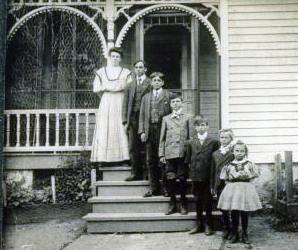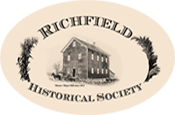Living into the 20th Century
in the Mill House by Linda Derrick
Third in a series
Our first article was about the Messer 's - The original owners of what is today the Richfield Historical Park. The Messer family built the saw mill, the grist mill and the mill house. The second article in our series was about the next owners of the property; i.e., the Mayer family. This third article continues the Mayer Family story.
The time is 1892. Both mill operations are prosperous. Charles Wilhelm (C.W.) and his wife Marianna have been living in the mill house for several years now. In addition to the mill operations, they are managing a full working farm; and their family is growing. They have a  4-year-old daughter named Louisa, a baby son named George and another baby due before the end of the year. Construction is underway to build an addition to the mill house which will double the size of the house. They don't know it yet; but over the next 11 years, their family will grow even bigger to include seven children. After daughter Louisa and son George, four more boys follow; and last of all, little Marie arrives in 1903. All the children are to be born and raised in the mill house.
4-year-old daughter named Louisa, a baby son named George and another baby due before the end of the year. Construction is underway to build an addition to the mill house which will double the size of the house. They don't know it yet; but over the next 11 years, their family will grow even bigger to include seven children. After daughter Louisa and son George, four more boys follow; and last of all, little Marie arrives in 1903. All the children are to be born and raised in the mill house.
As the children get older, the boys help their father with the daily  workings of the farm. They have crops in the field, as well as cows, chickens and pigs in the barn. There is an endless need for firewood to be chopped and stored in the woodshed. The boys need to haul wood into the house daily since it is their only source of heating and cooking. Each day they pump water from the well that stands outside the woodshed and take it into the house bucket by bucket. There is no running water inside.
workings of the farm. They have crops in the field, as well as cows, chickens and pigs in the barn. There is an endless need for firewood to be chopped and stored in the woodshed. The boys need to haul wood into the house daily since it is their only source of heating and cooking. Each day they pump water from the well that stands outside the woodshed and take it into the house bucket by bucket. There is no running water inside.
As the girls get older, they help their mother Marianna. There are  household chores and a big vegetable garden that needs tending throughout the summer. It takes an entire day to wash the weekly laundry and hang it out to dry. Another day each week is needed to iron clothes, and yet another day to get all the baking done. Bread and desserts are homemade, butter needs to be churned, eggs are collected and cows need milking as well. In the fall, it is harvest and threshing time. This is when they spend additional days canning fruits and vegetables.
household chores and a big vegetable garden that needs tending throughout the summer. It takes an entire day to wash the weekly laundry and hang it out to dry. Another day each week is needed to iron clothes, and yet another day to get all the baking done. Bread and desserts are homemade, butter needs to be churned, eggs are collected and cows need milking as well. In the fall, it is harvest and threshing time. This is when they spend additional days canning fruits and vegetables.
The Mayer family is better off than most families in the community, but they still work hard to make a living for themselves. However, it isn't all work and no play.
C. W. and Marianna love music. They have a record player which sits in their parlor. Many evenings the family enjoys listening to music that is recorded on wax cylinders and played on their Edison Victrola.
Growing up next to a mill pond, the children have lots of opportunity to go swimming and fishing in the summer and skating in the winter.
Sometimes the farmers who come to the mill to get their grain processed bring their children, and they visit and play with the Mayer children while the adults catch up on the latest news.
As life progresses into the 20th century, C. W. continues to do well operating the mills; and a few of his sons are helping to run them. C. W. is getting up there in years; and after a long and prosperous life, he dies of natural causes in 1917. Upon his death, two of his sons (George the oldest and Charles the youngest) take over operation of the mills. Marianna and the children continue to live in the mill house.
In 1922, at the age of 30, son George gets married. George's new  bride Martha joins him and the rest of the family to live in the mill house. George continues to run the mills with his brother Charles. Two years later, Martha gives birth to a son whom they name Vernon; and daughter Carol follows a few years after that. By this time, most of George's siblings are grown and gone; but his mother Marianna continues to live with them in the mill house.
bride Martha joins him and the rest of the family to live in the mill house. George continues to run the mills with his brother Charles. Two years later, Martha gives birth to a son whom they name Vernon; and daughter Carol follows a few years after that. By this time, most of George's siblings are grown and gone; but his mother Marianna continues to live with them in the mill house.
The 1920s are coming to an end, and there are changes ahead. New technology is on the horizon for the mills and the Mayer family.
To be continued ... "The next 50 years in the Mill House (1930s to 1970s)"
Hope you enjoyed this story
Enjoy our other stories

